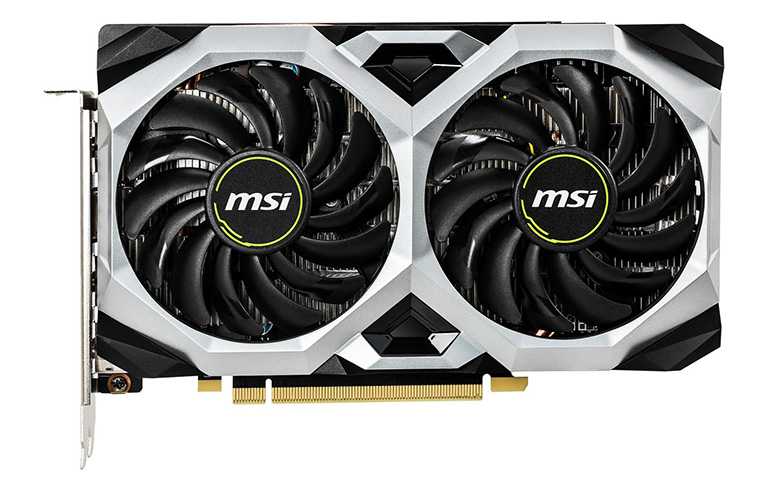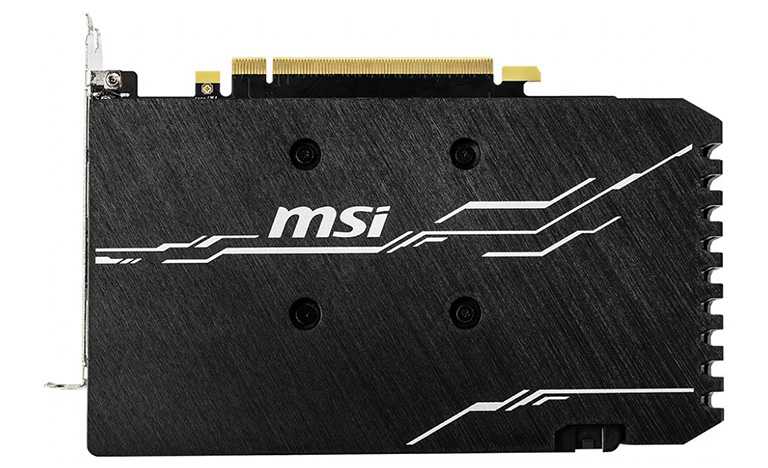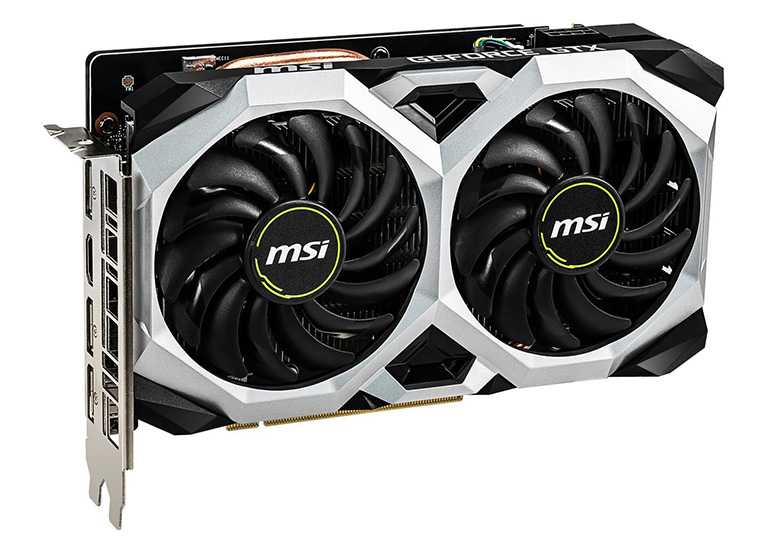Внешний вид
А вот и сама видеокарта ASUS TUF Gaming GeForce GTX 1660 OC Edition. Выглядит она не совсем обычно, хотя также снабжена двумя вентиляторами, которые обдувают цилиндрический радиатор. В этом и заключается вся необычность. Насколько эффективно такое решение мы узнаем во время тестирования.
Видеокарта получила полностью новый дизайн кожуха кулера, который имеет интересную военизированную окраску, подходящую под концепцию TUF Gaming.
Видеокарта довольно компактная, ее габариты — 205 x 123 x46 мм. печатная плата полностью скрыта от посторонних глаз, спереди ее закрывает большой кожух кулера, а сзади пластиковая пластина. Обычно бэкплейты делают алюминиевыми, но в данном случае используется пластик. Скажется ли это на температурном режиме, выясним чуть позже.
Система охлаждения, а точнее алюминиевый радиатор, закрепляются на видеокарте четырьмя винтами. Остальные винты фиксируют пластиковый кожух.
Вид на видеокарту с разных ракурсов. не смотря на большой кожух видеокарта занимает всего два слота.
На интерфейсной панели представлено три видеовыхода:
— DVI;
— HDMI;
— Display Port.
Радиатор обдувается двумя 76 мм вентиляторами, которые работают тихо даже на высоких оборотах. Скорость вращения крыльчатки от 1000 до 4000 об/мин.
Дополнительное питание видеокарта получает через разъем 8-Pin PCIe. В сумме видеокарта может потреблять до 225 Вт. Во время тестирования на стоковых частотах видеокарта потребляла около 120 Вт, а после разгона её энергопотребление увеличилось до 130 Вт.
Пластиковый кожух с вентиляторами снимается очень легко, под ним прячется небольшой алюминиевый радиатор с медным сердечником.
Вентиляторы произведены компанией FirstD.
Радиатор отводит тепло не только от графического процессора, но и от микросхем памяти. В тоже время система питания довольствуется только обдувом от вентиляторов, радиаторами силовые микросхемы не прикрыты.
Тыльная сторона печатной платы накрыта пластиковой панелью, которая носит декоративный характер.
Радиатор крепится на печатной плате при помощи четырех винтов.
В качестве термоинтерфейса для GPU используется термопаста, а для чипов памяти GDDR5 используются мягкие термопрокладки.
Печатная плата видеокарты ASUS TUF Gaming GeForce GTX 1660 OC Edition, не смотря на принадлежность к одной из самых доступных серий, может похвастаться высоким качеством изготовления. Во-первых, при производстве используется полностью автоматизированная линия с высоким качеством пайки. Это хорошо заметно по идеально ровному расположению компонентов на PCB. Во-вторых, технология AUTO-Extreme позволила производить пайку всех компонентов за один этап. А это значит, что PCB подвергается меньшим температурным нагрузкам и меньшему воздействию жестких химикатов, которые используются для очистки платы после пайки.
Главным компонентом видеокарты является графический процессор NVIDIA TU116-400-A1. Он изготовлен по 12 нм техпроцессу и может похвастаться наличием 1408 ядер CUDA, 48 блоками ROP, 88 блоками TMU. Номинальная тактовая частота графического процессора 1530 МГц, с автоматическим увеличением до 1980 МГц в режиме Boost. Обмен информацией с памятью GDDR5 осуществляется по 192-битной шине данных.
Вокруг GPU распаяно шесть микросхем памяти GDDR5. Чипы произведены компанией Micron и имеют маркировку 8KB77 D9VVR. Их номинальная частота 2000 МГц.
Система питания видеокарты ASUS TUF Gaming GeForce GTX 1660 OC Edition имеет 5 фаз, они выполнены по схеме 4 + 1. Четыре фазы выделено для питания графического процессора и одна фаза для питания памяти. В качестве силовых микросхем здесь используется сборки SIC638, которые могут выдерживать силу тока до 50 А, и одна микросхема FDPC5018SG, рассчитанная на нагрузку до 32 А. Рабочий температурный режим для всех микросхем может достигать 125 градусов.
Управляет преобразователем цифровой ШИМ-контроллер uP9512R.
Overclocking
MSI provides some pretty decent out of the box boost GPU clocks on the faster GeForce GTX 1660 Ti GAMING X graphics card, with 1875MHz boost GPU easily achieved without touching MSI Afterburner. However, cranking things up was a fun experience as my sample was able to get to over 2000MHz (just) with a max of around 2010MHz or so.
65
This resulted in 8-10% more performance in synthetic and game benchmarks, without using more power. The card ran 2C hotter at 67C total, so I played with the fan speeds to see if I could get the GTX 1660 Ti GAMING X running cooler, while overclocked. With the fans at auto the GPU was hitting 67C, fans at 75% the card hit 59C and at 100% fan speed I saw the temps drop to 56C.
It might not sound like much, but this results in a few more precious FPS in your favorite games. For example, the overclocked MSI GeForce GTX 1660 Ti GAMING X pushes up to 77FPS (from 75FPS) in Far Cry New Dawn at 1440p. In Rainbow Six Siege we’re looking at 95FPS at 1440p versus 90FPS, and 121FPS at 1080p versus 113FPS at stock clocks.
Specs: TU116 vs GP106
Specs: TU116 GPU
NVIDIA’s new Turing GPU architecture is a thing of beauty, sparking life into the mid-range sub-$300 segment with the GeForce GTX 1660 Ti, especially when you look at it spec-by-spec against the previous-gen GTX 1060. It might have the same 6GB framebuffer, but we’ve changed from GDDR5 to GDDR6, which results in a huge injection of memory bandwidth that helps the GTX 1660 Ti kick some serious ass at higher resolutions.
The new GeForce GTX 1660 Ti has 24 SMs and 1536 CUDA cores versus the Pascal-based GeForce GTX 1060 and its 10 SMs and 1280 CUDA cores. TU116 is much beefier than the GP106 used on the GTX 1060. GP106 has 4.4 billion transistors, versus the 6.6 billion in TU116 — as you can see, Turing is a beast even in TU116 form. This comes at a price of die size, with the GP106 coming in at 200mm2 while the TU116 is a much larger 284mm2 chip. GP106 was made on the 14nm node, while TU116 is made one the newer, smaller 12nm process.
GPU clocks are similar at a reference level with the GTX 1060 coming in at 1506/1708MHz for base and boost respectively, while the TU116 kicks off at 1500MHz base, but boosts up further to 1770MHz. The custom cards we have here today are faster again, with some nice wiggle room for overclocking. We have 96 texture units on the TU116 versus 80 texture units on the GP106, resulting in 169.9 Gigatexels/sec of texel fill-rate performance on the TU116 versus the 120.5 Gigatexels/sec.
NVIDIA is still using 6GB of VRAM on the new GeForce GTX 1660 Ti but has upgraded to faster GDDR6 memory, over the 6GB of GDDR5 used on the GTX 1060. This results in a huge upgrade in memory bandwidth from 192GB/sec on the GTX 1060, to a huge 288.1GB/sec on the new GTX 1660 Ti. NVIDIA has the GDDR6 clocked at 12Gbps on the GTX 1660 Ti, down from the 14Gbps on the faster RTX cards but considerably higher than the 8Gbps on the GTX 1060. This is a huge 50% more memory bandwidth, which is absolutely huge for a card at this price point.
NVIDIA has also managed to keep the TDP at just 120W on the GTX 1660 Ti, the same 120W TDP found on the GTX 1060. Impressive stuff, the blend of Turing, GDDR6, and the 12nm node helps the company achieve impressive performance per watt numbers.
Thermals, Power, Noise
Thermals
MSI never fails to impress when it comes to thermal performance on their TWIN FROZR 7 cooled graphics cards, and the new GeForce GTX 1660 Ti GAMING X is no exception. Under full complete load at any resolution for 30-60 minutes I recorded temperatures of 65C, with all settings on auto. I didn’t touch fan curves, fan speeds, overclocking, or anything else and still only hit 65C maximum.
65
Power
Another benefit is the 120W TDP that the GeForce GTX 1660 Ti rolls out with, which saw our full Core i7-8700K test bed consuming a total of 220-230W under load. I was running gaming and synthetic benchmarks under this test, ranging between the aforementioned 220-230W in tests like Heaven, and games like Apex Legends and Metro Exodus.
65
Noise
With the fans on auto I couldn’t hear the card making much noise at all under gaming loads, and when under 60C the fans will disable completely for absolute silent use.
Benchmarks — 1080p
1080p Benchmarks
65
Apex Legends is a surprise hit from Titanfall developer Respawn Entertainment, with the new 60-player battle royale game coming onto the scene in February and changing the game, literally. It’s an actual blast to play and we will now be using it in all of our graphics card content going forward.
65
65
EA and DICE put everything they had into Battlefield V which runs the latest version of the Frostbite engine, and really stretches its legs in terms of graphics quality and squeezing the most from our cards. It’s one of the best looking engines and best looking games on the market, until the new slew of games launches over the coming months, that is.
65
65
Overwatch is one of the most popular games on the market, from legendary game developer Blizzard. It’s a game that looks great but doesn’t require a huge amount of GPU grunt, but it’s tested for another reason: high-FPS for enthusiast/professional gamers. Overwatch in our testing is to provide a two-fold result: first, it’s a popular esports title and second it gives us a look at what we need to run it at 1440p for 144/165Hz displays and at 4K on those new 144Hz HDR G-Sync displays.
65
65
Middle-earth: Shadow of War is a sequel to the popular Shadow of Mordor, which was powered by the Lithtech engine. When cranked up to maximum detail, it will chew through your GPU and its VRAM like it’s nothing.
You can buy Middle-earth: Shadow of War at Amazon.
65
65
Rainbow Six: Siege has been a strong entry into the franchise, popular for its realistic feel and great graphics. Stable as a rock for benchmarking, right up to 3440×1440 and 4K.
65
65
Metro Exodus is one of the hardest tests that our graphics cards have to go through, with 4A Games’ latest creation being one of the best looking games on the market. It is a serious test that pushes GPUs to their limits, and also features RTX technologies like DLSS.
65
65
Far Cry New Dawn was developed by Ubisoft, and is powered the Dunia Engine, an engine that has been modified over the years for Far Cry and last used in Far Cry 5. Dunia Engine itself was a modified version of CRYENGINE, scaling incredibly well on all sorts of hardware.
65
65
Shadow of the Tomb Raider is one of the latest games to join our graphics card benchmark lineup, with the game built using the Foundation engine as a base, the same engine in Rise of the Tomb Raider. Eidos Montreal R&D department made lots of changes to the engine during the development of Shadow of the Tomb Raider to make it one of the best-looking games out right now.
65
Introduction
The Nvidia mainstream GPU stack of 2019 is finally taking shape following the launch of GeForce GTX 1660 Ti and GTX 1660. Based on the all-new Turing architecture but making do without the ray-tracing and tensor cores of the RTX line, these GPUs ship from £260 and £200, respectively.
Understanding that pricing is key when a number of graphics cards play in a congested field, we reckon the pair makes most sense at their base prices, because as our results have shown previously, you don’t receive a healthy dollop of extra performance by opting for a higher-spec model.
All of Nvidia’s partners have basic and premium models of each GPU in their arsenal. MSI hits the GTX 1660 Ti’s MSRP with the Ventus XS OC. Let’s take a look.

MSI does plenty of things right straight off the bat. The card does indeed achieve the base £260 price point, isn’t too large, has a core overclock in place, and eschews any form of lighting for a simpler aesthetic that’s unlikely to offend in any build.
Measuring 204mm x 128mm x 42mm and weighing 669g, the Ventus is a bit bigger than mini-ITX yet much more petite than triple-fan models that can be as much as 100mm longer. The shroud is constructed entirely from plastic and has enough angles and flared sections to offer a futuristic look. Ventus, it is good to know, doesn’t feature a hybrid fan mode where the spinners turn off, though we’re not concerned with that because the card is practically inaudible when doing not very much.
You’ll notice the card’s height is a fair bit taller than the standard-sized I/O bracket. This isn’t due to cooler overhang; rather, MSI uses a bigger PCB than is actually required. Knowing that the solitary 8-pin power connector is located along the top edge may cause the relevant PSU cable to brush up against the side panel on smaller chassis.

Removing the heatsink is a piece of cake because it is held on by four screws. Doing so reveals a wider-than-normal PCB that’s actually mini-ITX in length. It’s the need to house this specific cooler that pushes the length out.
MSI provides a specific heatsink for the VRMs and, going by the cooler, four thermal pads for the GDDR6 memory rated at 12Gbps. The single-heatpipe design — which makes good contact with the full-fat TU116 core — is disarmingly simple, though we feel the company misses a trick by not cooling the two memory chips at the bottom of the PCB.
The rear section serves as a brace for the topside heatsink and is made out of plastic — the two combine to form a frame on the right-hand side. We’d normally like to see a metal backplate but view this one more as a protective cover for the rear of the PCB — there are no meaningful components to cool on the back.

Most of the PCB components are visible from the side, including the thick heatpipe and rather ugly-looking 4-pin fan cable. As a consequence, much of the hot air is expelled back into your chassis, which is a trait the Ventus XS shares with many other budget coolers.
MSI sticks with the GTX 1660 Ti’s 120W TDP yet also lives up to its OC name by increasing the boost speed up from a default 1,785MHz to 1,830MHz. We’re impressed because even the fastest models of this card, costing over £300, are specified with a boost speed of just 1,875MHz. Kudos to MSI for offering an OC variant at the base £260 price.
Our logs show that it runs at an average 1,905MHz under continuous load, meaning that performance ought to be within a per cent or two of the best 1660 Tis around. Why spend more if you don’t have to?

Outputs are modern and conventional, however, with a trio of DisplayPort and a single HDMI. Is there a case for keeping DVI for older monitors?
MSI backs the card with a three-year warranty that is good to see on an entry-level board. Sadly, neither Nvidia nor MSI offer a gaming bundle with this model.
Упаковка и комплектация
Видеокарта ASUS TUF Gaming GeForce GTX 1660 OC Edition поставляется в красивой картонной упаковке, оформленной в темных тонах. Спереди нас как обычно встречает изображение самой видеокарты, ее название, логотип серии TUF Gaming и упоминание, что перед нами «разогнанная версия» видеокарты.
С противоположной стороны производитель привел технические характеристики устройства и отметил несколько важных моментов о видеокарте:
— 144-часовой стресс-тест, когда видеокарта подвергается высокой нагрузке при помощи популярного бенчмарка 3DMark и популярных игр Fortnite, Liga of Legends и Overwatch;
— двойной шарикоподшипник — оба вентилятора системы охлаждения снабжены двойным шарикоподшипником с удвоенным сроком службы, по сравнению со стандартными подшипниками скольжения;
— дополнительная защита — видеокарта снабжена дополнительной усилительной пластиной, которая защищает ее от провисания под тяжестью собственного веса и повреждений при транспортировке и установке видеокарты.
Внутри коробки видеокарта запакована в антистатический пакет и уложена в картонный лоток, сверху прикрытый мягким материалом.
Комплект поставки состоит из диска с драйвером и фирменным ПО, и инструкции по эксплуатации.

































